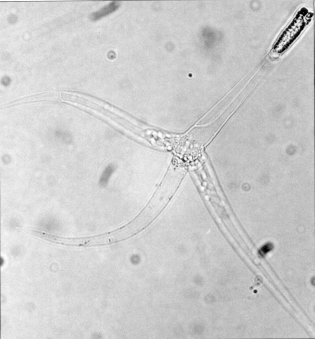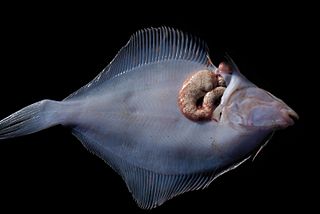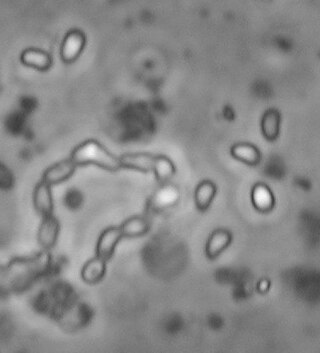Related Research Articles

In biology, a spore is a unit of sexual or asexual reproduction that may be adapted for dispersal and for survival, often for extended periods of time, in unfavourable conditions. Spores form part of the life cycles of many plants, algae, fungi and protozoa.

Myxozoa is a subphylum of aquatic cnidarian animals – all obligate parasites. It contains the smallest animals ever known to have lived. Over 2,180 species have been described and some estimates have suggested at least 30,000 undiscovered species. Many have a two-host lifecycle, involving a fish and an annelid worm or a bryozoan. The average size of a myxosporean spore usually ranges from 10 μm to 20 μm, whereas that of a malacosporean spore can be up to 2 mm. Myxozoans can live in both freshwater and marine habitats.

Myxosporea is a class of microscopic parasites, belonging to the Myxozoa clade within Cnidaria. They have a complex life cycle which comprises vegetative forms in two hosts, an aquatic invertebrate and an ectothermic vertebrate, usually a fish. Each host releases a different type of spore. The two forms of spore are so different that until relatively recently they were treated as belonging to different classes within the Myxozoa.
Nosema apis is a microsporidian, a small, unicellular parasite recently reclassified as a fungus that mainly affects honey bees. It causes nosemosis, also called nosema, which is the most common and widespread of adult honey bee diseases. The dormant stage of N. apis is a long-lived spore which is resistant to temperature extremes and dehydration, and cannot be killed by freezing the contaminated comb. Nosemosis is a listed disease with the Office International des Epizooties (OIE).

Microsporidia are a group of spore-forming unicellular parasites. These spores contain an extrusion apparatus that has a coiled polar tube ending in an anchoring disc at the apical part of the spore. They were once considered protozoans or protists, but are now known to be fungi, or a sister group to fungi. These fungal microbes are obligate eukaryotic parasites that use a unique mechanism to infect host cells. They have recently been discovered in a 2017 Cornell study to infect Coleoptera on a large scale. So far, about 1500 of the probably more than one million species are named. Microsporidia are restricted to animal hosts, and all major groups of animals host microsporidia. Most infect insects, but they are also responsible for common diseases of crustaceans and fish. The named species of microsporidia usually infect one host species or a group of closely related taxa. Approximately 10 percent of the species are parasites of vertebrates —several species, most of which are opportunistic, can infect humans, in whom they can cause microsporidiosis.

Eimeria is a genus of apicomplexan parasites that includes various species capable of causing the disease coccidiosis in animals such as cattle, poultry and smaller ruminants including sheep and goats. Eimeria species are considered to be monoxenous because the life cycle is completed within a single host, and stenoxenous because they tend to be host specific, although a number of exceptions have been identified. Species of this genus infect a wide variety of hosts. Thirty-one species are known to occur in bats (Chiroptera), two in turtles, and 130 named species infect fish. Two species infect seals. Five species infect llamas and alpacas: E. alpacae, E. ivitaensis, E. lamae, E. macusaniensis, and E. punonensis. A number of species infect rodents, including E. couesii, E. kinsellai, E. palustris, E. ojastii and E. oryzomysi. Others infect poultry, rabbits and cattle. For full species list, see below.
Microsporidiosis is an opportunistic intestinal infection that causes diarrhea and wasting in immunocompromised individuals. It results from different species of microsporidia, a group of microbial (unicellular) fungi.

A xenoma is a growth caused by various protists and fungi, most notably microsporidia. It can occur on numerous organisms; however is predominantly found on fish.
Enterocytozoon bieneusi is a species of the order Chytridiopsida which infects the intestinal epithelial cells. It is an obligate intracellular parasite.

Henneguya zschokkei or Henneguya salminicola is a species of a myxosporean endoparasite. It afflicts several salmon in the genera Oncorhynchus and Salmo. It causes milky flesh or tapioca disease. H. zschokkei is notable for its lack of mitochondria, mitochondrial DNA, aerobic respiration and its reliance on an exclusively anaerobic metabolism.
Nosema ceranae is a microsporidian, a small, unicellular parasite that mainly affects Apis cerana, the Asiatic honey bee. Along with Nosema apis, it causes the disease nosemosis, the most widespread of the diseases of adult honey bees. N. ceranae can remain dormant as a long-lived spore which is resistant to temperature extremes and dehydration. This fungus has been shown to act in a synergistic fashion with diverse insecticides such as fipronil or neonicotinoids, by increasing the toxicity of pesticides for bees, leading to higher bee mortality. It may thus play an indirect role in colony collapse disorder. In addition, the interaction between fipronil and N. ceranae induces changes in male physiology leading to sterility.
The microsporidian Cucumispora dikerogammari is a parasitic fungal species that infects the invasive amphipod Dikerogammarus villosus. The first recorded evidence of Cucumispora dikerogammari was, as cited by Ovcharenko and Vita, in Germany, circa 1895, by Dr. L. Pfeiffer in the Dnieper Estuary. The Dnieper Estuary and lower parts of the Danube River are considered to be the parasite’s native range. As its host, D. villosus, began to invade novel habitats, C. dikerogammari followed, and has now expanded its range to be found in many of the main bodies of water in Central and Western Europe. At this time, only limited research has been conducted regarding the ecological implications of C. dikerogammari spreading beyond its native range. However, there is evidence to suggest that C. dikerogammari may cause imbalance to the male/female sex ratio of its host D. villosus.
Gadimyxa atlantica is a species of parasitic myxozoan. Together with G. arctica and G. sphaerica, they infect Gadus morhua and Arctogadus glacialis by developing coelozoically in bisporic plasmodia in their urinary systems. These 3 species' spores exhibit two morphological forms: wide and subspherical, being both types bilaterally symmetrical along the suture line. The wide spores have a mean width ranging from 7.5-10μm, respectively, while the subspherical ones range from 5.3-8μm in mean width. The subspherical forms of Gadimyxa are similar to Ortholinea, differing in the development of the spores and in the arrangement of the polar capsules. Polychaetes Spirorbisspecies act as invertebrate hosts of G. atlantica.
Gadimyxa sphaerica is a species of parasitic myxozoan. Together with G. arctica and G. atlantica, they infect Gadus morhua and Arctogadus glacialis by developing coelozoically in bisporic plasmodia in their urinary systems. These 3 species' spores exhibit two morphological forms: wide and subspherical, being both types bilaterally symmetrical along the suture line. The wide spores have a mean width ranging from 7.5 to 10μm, respectively, while the subspherical ones range from 5.3-8μm in mean width. The subspherical forms of Gadimyxa are similar to Ortholinea, differing in the development of the spores and in the arrangement of the polar capsules.
Gadimyxa arctica is a species of parasitic myxozoan. Together with G. atlantica and G. sphaerica, they infect Gadus morhua and Arctogadus glacialis by developing coelozoically in bisporic plasmodia in their urinary systems. These 3 species' spores exhibit two morphological forms: wide and subspherical, being both types bilaterally symmetrical along the suture line. The wide spores have a mean width ranging from 7.5-10μm, respectively, while the subspherical ones range from 5.3-8μm in mean width. The subspherical forms of Gadimyxa are similar to Ortholinea, differing in the development of the spores and in the arrangement of the polar capsules.

Ordospora colligata is an intracellular parasite belonging to the Microsporidia. It is an obligatory gut parasite with the crustacean Daphnia magna as its only host. So far it has been reported from Europe and Asia.

Hamiltosporidium is a genus of Microsporidia, which are intracellular and unicellular parasites. The genus, proposed by Haag et al. in 2010, contains two species; Hamiltosporidium tvaerminnensis, and Hamiltosporidium magnivora. Both species infect only the crustacean Daphnia magna (Waterflea).
Ceratomyxa hooperi is a myxosporean parasite that infects gall-bladders of serranid fishes from the Great Barrier Reef. It was first found on Epinephelus quoyanus.
Ceratomyxa nolani is a myxosporean parasite that infects gall-bladders of serranid fishes from the Great Barrier Reef. It was first found on Epinephelus quoyanus.
Nematocida parisii is a parasitic species of Microsporidia fungi found in wild isolates of the common nematode, Caenorhabditis elegans. The fungus forms spores and replicates in the intestines before leaving the host.
References
- 1 2 Americus, Benjamin; Lotan, Tamar; Bartholomew, Jerri L.; Atkinson, Stephen D. (2020). "A comparison of the structure and function of nematocysts in free-living and parasitic cnidarians (Myxozoa)". International Journal for Parasitology. 50 (10–11): 763–769. doi:10.1016/j.ijpara.2020.04.012. PMID 32707121.
- ↑ Xu, Yanji; Weiss, Louis M. (2005). "The microsporidian polar tube: A highly specialised invasion organelle". International Journal for Parasitology. 35 (9): 941–953. doi:10.1016/j.ijpara.2005.04.003. PMC 3109658 . PMID 16005007.
- ↑ Frixione, Eugenio; Ruiz, Lourdes; Santillán, Moisés; De Vargas, Lourdes V.; Tejero, José M.; Undeen, Albert H. (1992). "Dynamics of polar filament discharge and sporoplasm expulsion by microsporidian spores". Cytoskeleton. 22 (1): 38–50. doi:10.1002/cm.970220105.